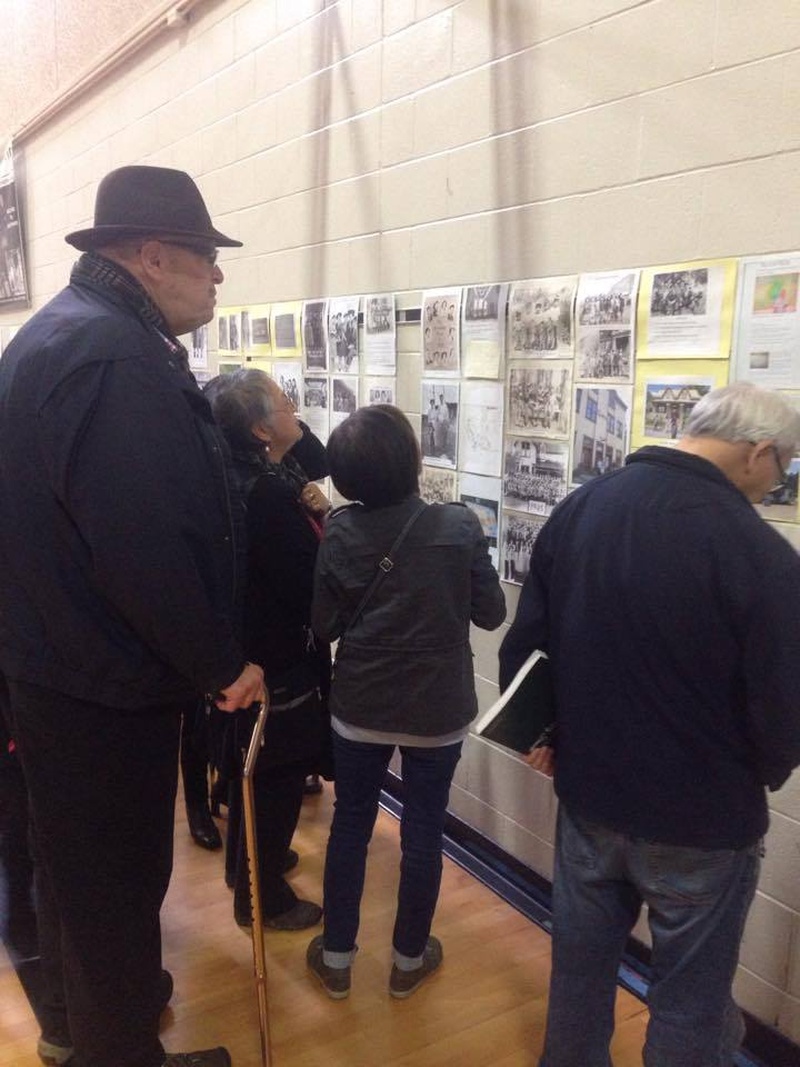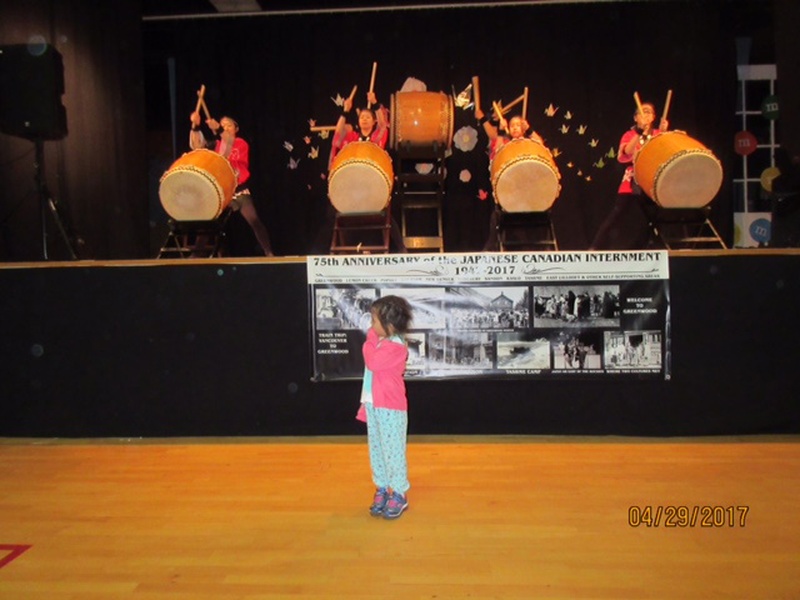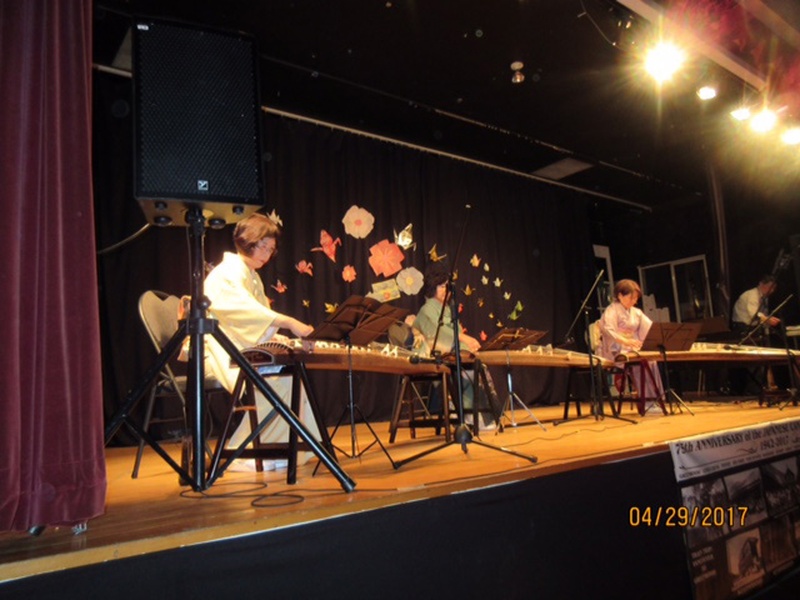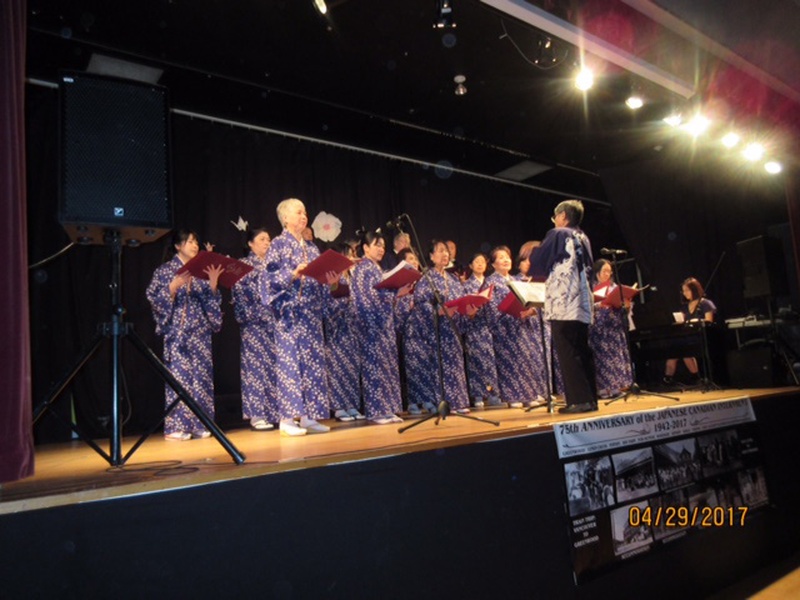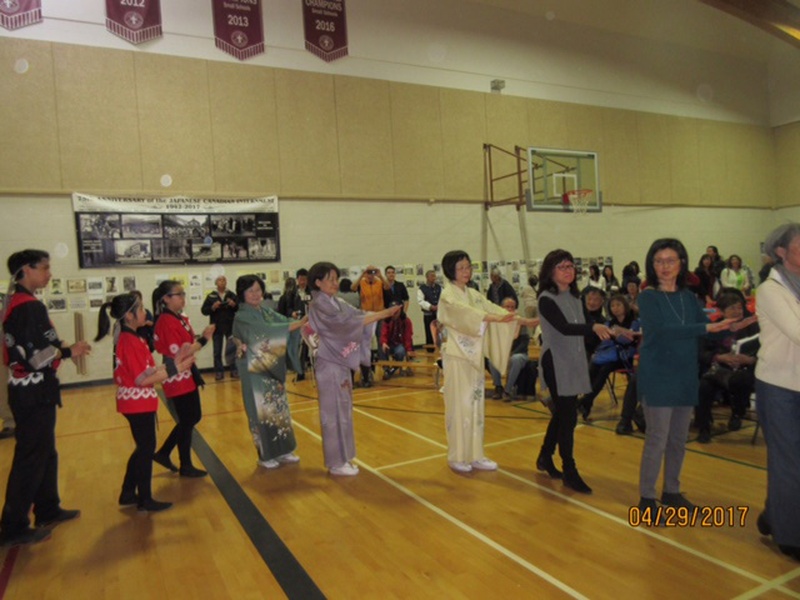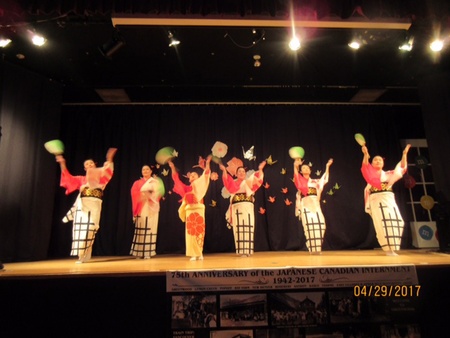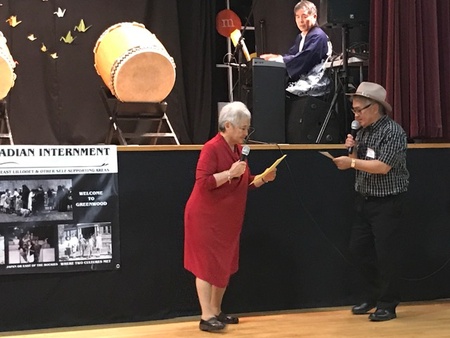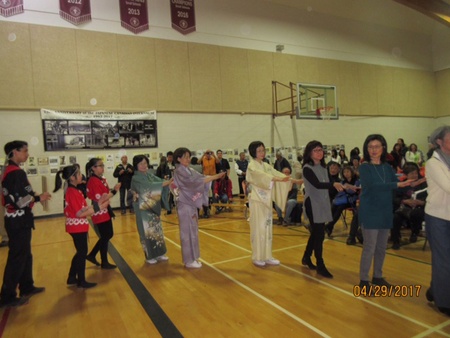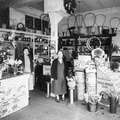What was to be a simple, casual get-together to commemorate the 75th Anniversary of the Japanese Canadian Internment, a Nikkei “Woodstock-like Love-in” occurred at St. Joseph the Worker School in Richmond on April 29th!
The gym was packed and many people seem to enjoy seeing old friends, reconnecting with long-lost friends and meeting Nikkei from other camps. There were lot of smiles and heart-warming surprises.
Erica Isomura who made the beautiful poster also ran the slideshow of ten internment camps contributed by National Nikkei Museum. Crowds gathered at the photo display to see if they could find old friends at various camps. Mike Kerr’s 75th Anniversary Internment banners showed the timeline. The added bonus was the Tashme Museum display of old artifacts. Ryan Ellan generously donated his time, print and coaster set to the event. Laura Saimoto was excited to take the old Tashme school double-desk to the Japanese Language School.
Raffle and silent auction were a big hit! There was some hot bidding for certain items, especially the 100-year old Ladner duck decoys donated by Wayne Kilvert. Kathleen Quo Vadis’ floral arrangement was popular too. Themed gift baskets, crafts, paintings, prints and sports jerseys were donated by family, friends and artists. Designer hand-made Japanese shawl and vests were donated by Yvonne Wakabayashi and Lurana Tasaka.
The standing room only crowd enjoyed the fabulous entertainment. Roku Shichi Taiko led by Doug Masuhara started the concert with a bang! Sakura Singer sang beautifully the Four Season Medley. Toshiko Shibano accompanied the choir and Chris Nakahori directed. Next up was Kotonone Kai under the guidance of Nariya Sensei with her koto students, Kazuko Komada and Sachiko Katz. Chiyoko Hirano brought her lovely Tatsumi Ryu Dancers as they graced the stage with their eye-catching kimonos and they danced flawlessly. Young Mia Sugihara caught the audience attention with her solo number. For the grand finale, Yoko Nakagawa of Summerland led the Sing-along and Tatsumi Ryu dancers finished the concert with Tanko Bushi.
Of course, this event was to thank and honour the Issei and Nisei who bore the brunt of the incarceration. They overcame hardships by persevering while keeping their dignity and humility. The speech by Chuck Tasaka was to acknowledge the ‘Unsung Heroes’:
"We came here today to THANK the ISSEI (1st generation) and NISEI(2nd) who were affected by the War Measures Act in 1942. Sadly, the Issei generation is gone now. Even the Niseis are now in their late 80’s and 90’s. Your perseverance, resilience, and strength enabled you to overcome adversity during those trying years. We, the younger generation, are so proud and filled with gratitude that you were exemplary role models for us by being good, law-abiding Canadian citizens. Without the right to vote in your time, your careers were limited. 75 years ago, Naomi Yamamoto would have been denied in the political arena. Teaching, Medicine and other professions were available only in your own ethnic community. For some, high school prom or university education was cut short. If B.C. politicians did this only to gain more votes, it was unfortunate. I know what Mr. T of A-Team would have said, “ I pity the fools!” 75th is a special year because many of us may not be able to wait for the 100th. I will be 96 years old!
Who are the Unsung Heroes? I want to talk about the people who did RIGHT, instead of those who did WRONG. Fittingly, the first person is Ethel Tibbits. I was reading Mits Yesaki’s book, ‘Sutebuston’. By chance, I came across Ethel’s name who was the managing editor of the Marpole-Richmond Review newspaper in the 30’s and 40’s. Ethel Tibbits was the defender of the Japanese Canadians. In one of her editorials, she blasted the B.C. politicians for sending away loyal, humble fishermen and market gardeners while the government ignored B.C. exporting scrap metal to Japan. She is truly our unsung hero. Good things happen to good people. There is an Ethel Tibbits high school scholarship and Women of Distinction Award right here in Richmond. We thank you.
Mayne Island showed their support in the Gulf Islands. Mayne Islanders walked down to the dock with their Nikkei friends and neighbours to bid a tearful farewell in 1942. Sixty years later, local resident like Don Herbert and his many volunteers created a beautiful Japanese Garden to honour the Nikkei Pioneers. Thank you Mayne Islanders.
I like to share this story about the Franciscan Sisters of the Atonement and Friars. Thanks to Jacqueline Gresko, she wrote about Kathleen O’Melia, or Omelia-san to the Nikkei, [who] was ordained Sr. Mary Stella at the age of 57.
How surreal is this? This is where it all started in 1942. There was a Japanese Catholic Mission in East Vancouver on Dunlevy and Cordova which was established by Sr. Mary Stella in 1926. In 1930-31, Sr. Mary Stella and Sr. Antoinette started a Japanese Catholic Mission in Steveston by knocking on all the doors of the cannery row houses to offer Day Care and English classes. They were able to convert about two hundred Japanese Canadians to Catholicism in a very staunch Buddhist community. Fr. Peter Baptist Katsuno was the first B.C. Japanese Canadian to be ordained in 1940. Franciscan Sisters of the Atonement and Friars became St. Joseph the Worker. It has come FULL circle.
The story of the internment began 75 years ago. The Japanese Canadians were declared ‘enemy aliens’ and the forced relocation process began in February of 1942. This was a time of uncertainty. No one knew where they were going. One lady asked Fr. Benedict Quigley to find them a safe place to go.
Father Quigley went above and beyond the call of duty to travel to Nelson, B.C. to meet with Bishop Martin Johnson. He said that a mayor in Greenwood would accept the Japanese Canadians. Father and then Mayor W.E. McArthur Sr. met and collaborated to bring the first wave of Nikkei, mostly Catholics from Steveston and Vancouver. Fortunately, Greenwood community’s vote was almost unanimous after the third meeting. The clincher was: If the Sisters and Friars would be 100% responsible for the welfare of the newcomers. Sr. Eugenia, Sr. Jerome and Fr. Benedict left on April 24th to Greenwood so that the parishioners would see familiar faces when they arrived.
So, on April 26th, the first train arrived at Greenwood Station. Mayor McArthur had his welcoming group to greet the tired Nikkei after an 18-hour train ride on the Kettle Valley Railway.
Greenwood was the FIRST community to accept the exiled Japanese Canadians, thus making it the first internment site. We must give our thanks to the City of Greenwood, Mayor McArthur, Fr. Quigley and to the Franciscan Sisters for their compassion.
The Sisters established Sacred Heart School while the provincial and federal government were arguing as to who was responsible for the education of the Nikkei children. Greenwood Nikkei children were lucky in that education began almost immediately. Other camps took nearly a year to have a school. Since there were so many children going to SHS, first group attended in the morning and the second half went in the afternoon. Sr. Mario taught Commercial class after school.
In the 1945 SHS Grade 8 Grad speech, Mayor McArthur thanked the Sisters stating that they worked for free and they did not go on strike. Greenwood provided many activities for the energetic ‘Yancha Kozo’. Mits Yesaki wrote in his book that Greenwood Nikkei had the lowest juvenile delinquency rate amongst the camps. I chuckled when I read it. Greenwood kids were smart, they didn’t get caught!
The United Church did their part in Greenwood as well. Madeline Bock, her mother and Grace Namba had a kindergarten class for their parishioners, and a girls club called CGIT. The boys called it “Craziest Girls in Town”. Later on, I found out the acronym, Christian Girls in Training.
Camps in the Slocan area were mostly Protestants run by the Women’s Missionary Service. Gwen Suttie, a United Church missionary organized educational facilities in that area. She hired John Stanley Rowe to teach at Lakeview Collegiate High School and math at Lemon Creek. Hide Hyodo oversaw the curriculum by hiring young high school graduates to teach. Grace Tucker, an Anglican Church social worker helped to oversee the conditions in the camps. She later resettled many Nikkei families to Ontario after the war. Grace was awarded the Order of Canada.
There was a Catholic Notre Dame High School run by the Quebec Nuns (Notre Dame des Anges). Most of the students weren’t Catholic but they were very happy to have a high school.
We must also thank the Doukhbors for providing fresh fruits and vegetables when food wasn’t plentiful. BCSC later put a blockade to keep them out.
In Kaslo, Kosaburo Shimizu was the reverend at St. Andrews United Church. Aya Higashi was the last Nikkei in Kaslo. A street will be named in her honour.
In Tashme, kindergarten was run by Anglican Church while United Church teachers taught elementary and high school. Do names like Winifred Awmack and Reverend Wilbert Roy McWilliams come to mind?
Sandon was mostly Buddhists. The ghost town was called ‘Sunless City’. [It was because] it was deemed dangerous with avalanche that this camp was the first to close.
East Lillooet had Dr. Miyazaki and Kaye Kaminishi to break the ice in the self-supporting area. In the beginning, internees were not allowed to cross that bridge into town, but a simple game of softball organized by the RCMP and Kaye Kaminishi broke the barrier.
When war ended, Japanese Americans were allowed to return to the coast. However, the Canadian government enforced an Emergency Power Act to delay the return. The next step was “Go East of the Rockies or Repatriate to Japan”. At this time, Greenwood Board of Trade protested against this unfair legislation and asked that Japanese Canadians stay in Greenwood. As a result, most were not pressured to leave. Thus, Nikkei population was around 700 who made Greenwood their home. New Denver also protested. Approximately 200 planted their roots in the 50’s.
Those who chose to go to Toronto, Montreal or Winnipeg, the Jewish community hired the Nikkei as an act of compassion and empathy.
On behalf of the Nikkei community, I would like to thank the church groups and unsung heroes for their contribution. Hall of Famer Yogi Berra of the NY Yankees once said, “It’s déjà vu all over again.” Will it? New immigrants are coming and will they face the same ordeal as the Nikkei? Maybe, not the discriminatory laws. Lest we forget, we must remember the internment history.
The motto for the Japanese Americans’ Bainbridge Island Memorial is “Ni do Tomo”( Never Again). In Hawaii, it’s Okagesama(Gratitude). What will the B.C. motto be? Thank you Issei, Nisei and to all the unsung heroes. I’m sure there were more, Gerry Miller and Bob Hepples in Steveston.
Many thanks to my large family, Nikkei Museum, to all the performers, Patrick Li, friends, relatives and donors to help make this special 75th Anniversary an overwhelming success. Grants came generously from The Greenwood Improvement Society, Boundary Heritage Credit Union and NAJC. The WWI Memorial Monument for the Greenwood JC vets, interpretive panels and the illuminated sign NIKKEI LEGACY PARK will come to fruition. Landscaping will be the next project."
© 2017 Chuck Tasaka



